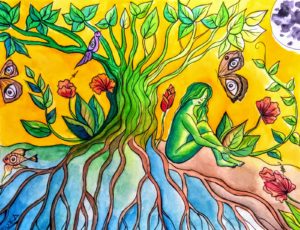A boy holds a shawl out to dry in the wind, and a mama holds her child’s hand to the father’s belly as the three ride by on a motorcycle. No helmets. Six adults lie on a hard flat bed, not watching TV, but watching the world. So many people stare with the white whites of their eyes. The cow tucks its head like a dog into its chest, and a woman sleeps under the tree beside the highway. Behind her, a shrine to Krishna. What do all the colors mean? I look for yellow.
A bridge floods and the boys climb up the other side to escape. A master said, “Life is to be lived, enjoyed.” Helmets are sold here by the dozens along the highway, each helmet wrapped in its own plastic bag. How many accidents happen daily? Every honk on the road has its own distinct voice. Trill a trill, like a cellphone’s ring or a bird’s call. Squatting at the banks of the river, the children play, but don’t drink the water. They live outside the City of Wishes, but it seems to be crumbling. Growing up, I was told never to stare, but I want to stare back at everyone here.

The city is built in stages. Buildings are frozen in permanent construction. There is a lotus flower gate and old honeycomb walls. Ring the golden bell when you enter the pink shrine. A light brown monkey runs across the roof of an apartment building, and a barbershop requires only a chair, shaving cream, and a razor. I pass dozens of these shops in the shadows. Men receive their morning shave, their eyes up. I wonder where are the dead buried in a city so full.
Uninhabited buildings are home to more monkeys. They choose not to live in trees, which are sparse here. A horse drawn buggy rolls past, and the white horse is stained pink for a festival. Holi? Not this time of year. So many more men than women. They’re everywhere. In the bus, the roads, the metro.
Is there a female goddess of war? Shiva holds tightly to his weapons. A young man sits on the bank and watches something invisible to me in the water. There are papaya trees behind him. All the horses that pull carts are white and therefore, all have rainbows. I see two white people. A girl smiles at us and waves. The men continue to stare.
White, again, in a tunic that blows from a stick in a field. It’s a scarecrow. An Indian scarecrow. Men and women squat in the same field, picking vegetables or just talking. A lime parrot watches overhead, perched on a phone cable. The next field over, a woman in a mint sari walks slowly through a field that’s shamrock green. The two greens burn together. There are shepherds with goats and sheep, and some goats look like marble cake, all vanilla-chocolate swirled.
Up above, clouds of pollution float, or maybe its smoke. It adds a milkiness to the sky, easy to mistake the mass for a cloud. But it’s not. I cannot see the sun in the middle of the day here. It’s covered. Just as there isn’t much blue either. It, too, only appears in small patches. The white birds are friends to the cows here, just like they are in Costa Rica. Some symbiotic relationship. Or perhaps their purpose is simply to keep one another company. And more polka-dotted goats walk by now with their humans in tow, or the humans walk their goats ahead of them, and they’re all in a line.
I cannot see inside the thatched structures from the highway bus. So many of them, woven and upright. Curved at the top. They’re all built with their doors facing away from the road. There are families in front of their entrances, and they look up at the bus now and then. They’re in Privacy. It’s not so obvious their back is turned. This kind of seeing is one-sided.




